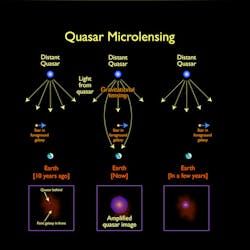Deep-space naturally occurring microlensing probes galactic events
Natural gravitational 'microlenses' can provide a way to probe active galactic nuclei (AGNs)--cores of high-energy very distant galaxies about the size of our own solar system. Now, a team of astronomers have seen hints of the extreme AGN brightness changes that hint at their presence. Leading the microlensing work, PhD student Alastair Bruce of the University of Edinburgh (Edinburgh, Scotland) has presented this work at the National Astronomy Meeting in Nottingham.
RELATED ARTICLE: Optical instruments identify exoplanets [including microlensing]
As cosmic gas spirals towards a black hole it speeds up and forms a disc, which heats up and releases energy before the gas meets its demise. Scientists are particularly interested in seeing what happens to the gas as it approaches the black hole. But studying such small objects at such large distances is tricky, as they simply look like points of light in even the best telescopes. Spectroscopic observations show that fast moving clouds of emitting material surround the disc but the true size of the disc and exact location of the clouds are very difficult to pin down.
Bruce described how astronomers can make use of cosmic coincidences, and benefit from a phenomenon described by Einstein's general theory of relativity more than a century ago that says light travels in curved paths under the influence of a gravitational field. So massive objects like black holes, but also planets and stars, can act to bend light from a more distant object and effectively become a lens.
This means that if a planet or star in an intervening galaxy passes directly between the Earth and a more distant AGN, over a few years or so they act as a lens, focusing and intensifying the signal coming from near the black hole. This type of lensing, due to a single star, is termed microlensing. As the lensing object travels across the AGN, emitting regions are amplified to an extent that depends on their size, providing astronomers with valuable clues.
Bruce and his team believe they have already seen evidence for two microlensing events associated with AGN. These are well described by a simple model, displaying a single peak and a tenfold increase in brightness over several years. Microlensing in AGNs has been seen before, but only where the presence of the galaxy was already known. Now Bruce and his team are seeing the extreme changes in brightness that signifies the discovery of both previously unknown microlenses and AGNs.
Bruce says, "Every so often, nature lends astronomers a helping hand and we see a very rare event. It's remarkable that an unpredictable alignment of objects billions of light years away could help us probe the surroundings of black holes. In theory, microlensing could even let us see detail in accretion discs and the clouds in their vicinity. We really need to take advantage of these opportunities whenever they arise."
There are expected to be fewer than 100 active AGN microlensing events on the sky at any one time, but only some will be at or near their peak brightness. The big hope for the future is the Large Synoptic Survey Telescope (LSST), a project the UK recently joined. From 2019 on, it will survey half the sky every few days, so has the potential to watch the characteristic changes in the appearance of the AGNs as the lensing events take place.
SOURCE: Royal Astronomical Society; http://www.ras.org.uk/news-and-press/2883-in-the-blink-of-a-cosmic-eye-chance-microlensing-events-probe-galactic-cores
About the Author

Gail Overton
Senior Editor (2004-2020)
Gail has more than 30 years of engineering, marketing, product management, and editorial experience in the photonics and optical communications industry. Before joining the staff at Laser Focus World in 2004, she held many product management and product marketing roles in the fiber-optics industry, most notably at Hughes (El Segundo, CA), GTE Labs (Waltham, MA), Corning (Corning, NY), Photon Kinetics (Beaverton, OR), and Newport Corporation (Irvine, CA). During her marketing career, Gail published articles in WDM Solutions and Sensors magazine and traveled internationally to conduct product and sales training. Gail received her BS degree in physics, with an emphasis in optics, from San Diego State University in San Diego, CA in May 1986.
